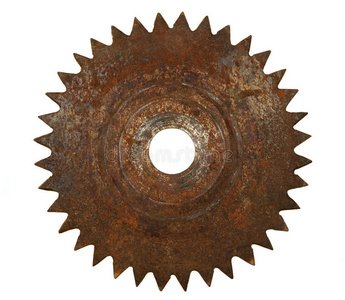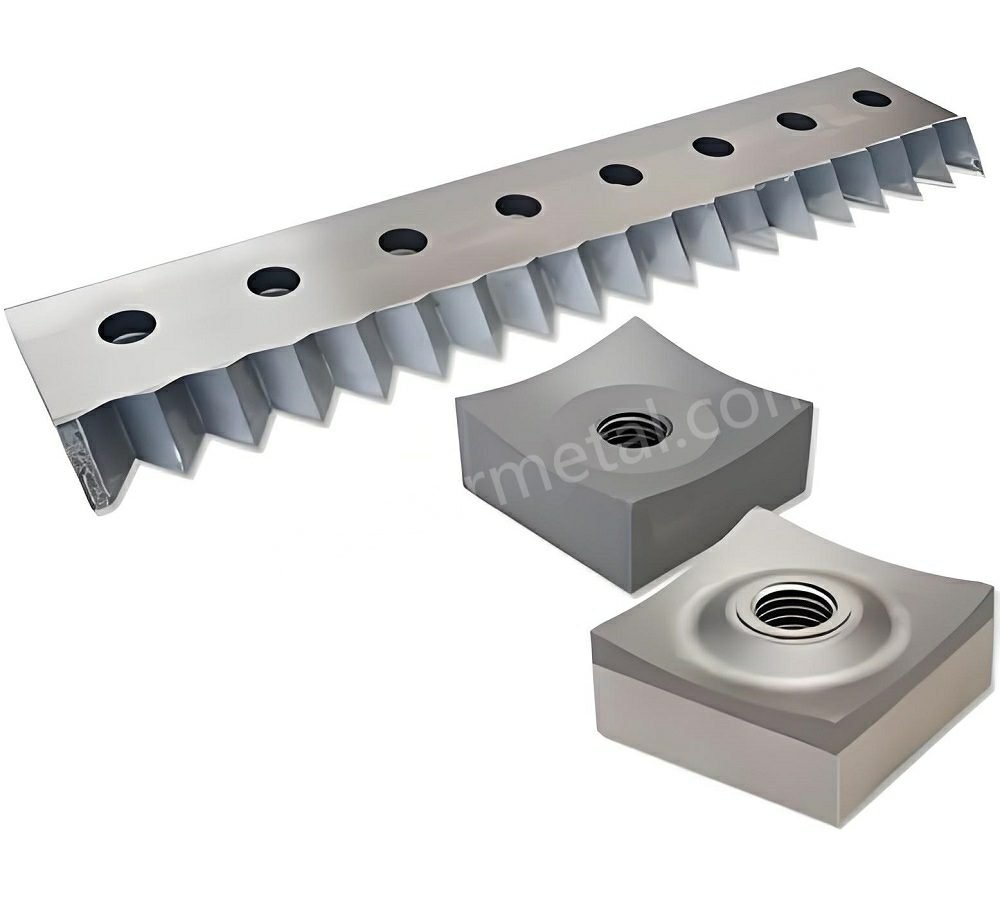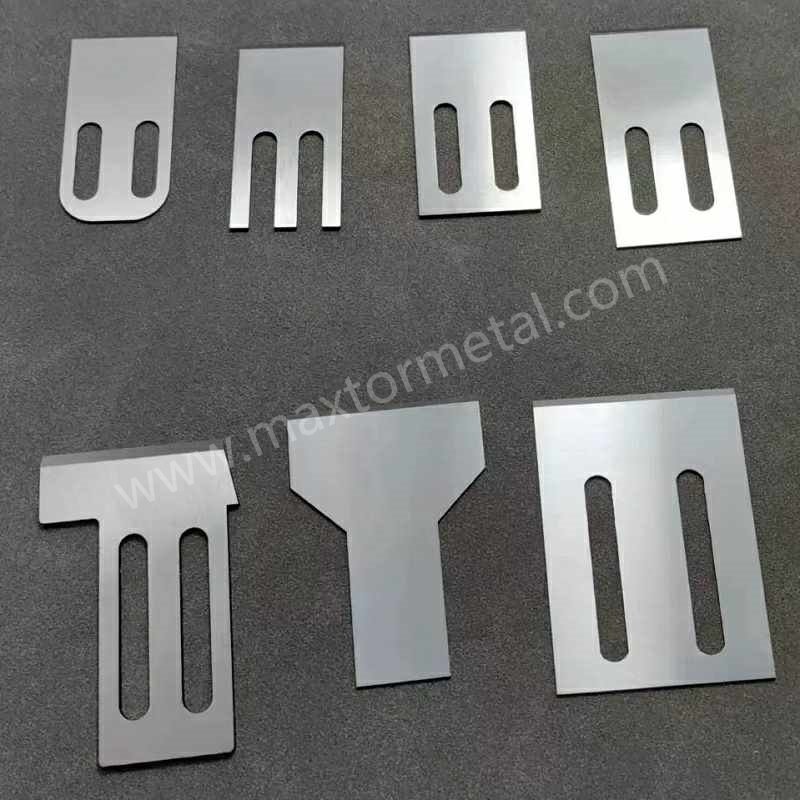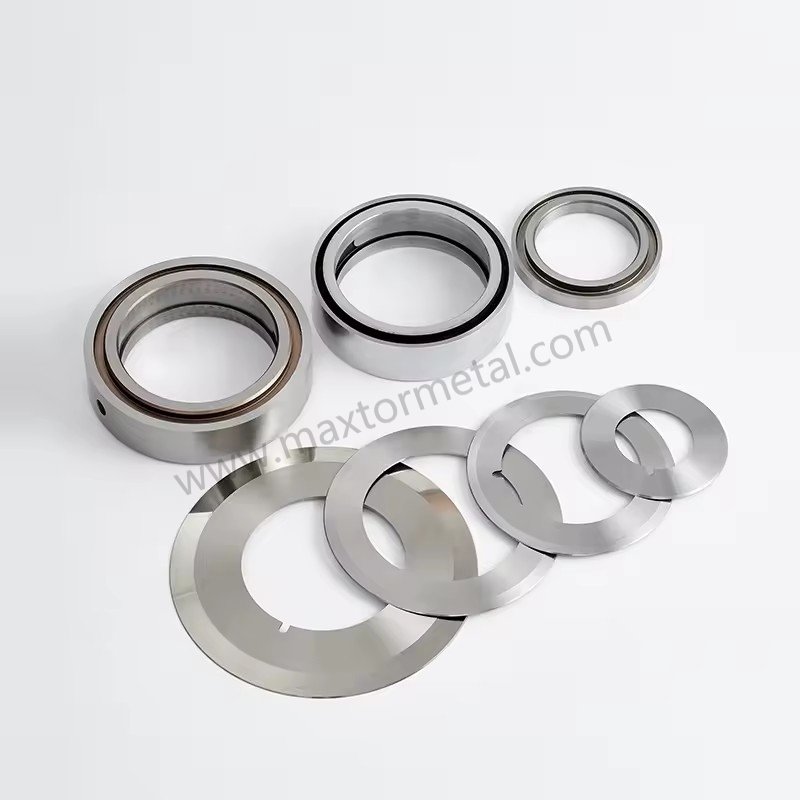
La rouille peut endommager les lames mécaniques, compromettant leurs performances, leur durée de vie et leur fiabilité. Pour les entreprises des secteurs de la fabrication, de la construction et autres secteurs qui dépendent d'outils de précision, l'antirouille n'est pas seulement une stratégie de maintenance : c'est un investissement en productivité et en économies. À l'échelle mondiale, la corrosion coûte à l'économie environ 1500 milliards de livres sterling par an, selon une étude. Association nationale des ingénieurs en corrosion (NACE) Protéger vos lames mécaniques contre la rouille n'est pas une option ; c'est essentiel pour pérenniser vos opérations et conserver un avantage concurrentiel.
Materials for Rustproofing Mechanical Blades
La première étape pour protéger les lames mécaniques contre la rouille consiste à choisir les bons matériaux. Tous les métaux ne se valent pas en termes de résistance à la corrosion. Voici un aperçu des matériaux à prendre en compte :
Choisir le bon acier
Le choix de l'acier a un impact direct sur les performances, la durabilité et la résistance à la rouille de la lame. Examinons de plus près la sélection du matériau idéal.
- Acier inoxydable (nuances austénitiques, par exemple 304 et 316) : Contient du chrome (16–18%) et du nickel (8–12%), formant une couche d'oxyde protectrice robuste. La nuance 316, contenant du molybdène 2–3%, offre une résistance supérieure en milieu marin et en milieux riches en chlorures.
- Exemple: Lors d'un test au brouillard salin ((ASTM B117)Le grade 316 surpasse le 304 en durant plus de 1 000 heures sans corrosion significative.
- Acier au carbone (nuances à faible teneur en alliage) : Malgré son coût avantageux, l'acier au carbone se corrode rapidement s'il n'est pas revêtu ou traité. Un revêtement de zinc ou de phosphate peut retarder, mais pas éliminer, la formation de rouille.
- Acier à outils (variétés à haute teneur en carbone) : Largement utilisé pour les applications de coupe en raison de sa dureté et de sa tenue des arêtes. Cependant, sa faible teneur en chrome (~4%) nécessite une protection de surface supplémentaire, comme un revêtement ou une passivation.
Comparaison de la résistance à la rouille des types d'acier
Affinons le tableau précédent avec des détails et des données plus précis.
| Type d'acier | Résistance à la rouille | Coût par kg | Résistance à la traction (MPa) | Applications |
| Acier inoxydable 316 | Haut | $5–$7 | 500–700 | Outils marins, traitement chimique |
| Acier inoxydable 304 | Modéré | $4–$6 | 520–750 | Outils de qualité alimentaire, lames générales |
| Acier au carbone 1050 | Faible | $1–$2 | 600–900 | Lames de base en milieu sec |
| Acier à outils D2 | Modéré | $10–$12 | 1900–2100 | Outils de coupe de précision, moules |
Éléments d'alliage et leurs effets
- Chrome (Cr) : Un élément essentiel de la résistance à la corrosion. La couche d'oxyde de chrome (film passif) est autoréparatrice et ne nécessite que 10,51 TP4T de chrome pour s'activer. Des teneurs en chrome plus élevées (par exemple, dans le 316) améliorent la résistance dans des conditions difficiles.
- Fait amusant : L'augmentation du chrome de 13% à 18% réduit la sensibilité à la rouille dans des conditions acides jusqu'à 40%.
- Nickel (Ni) : Améliore la ductilité et la ténacité de l'alliage, essentielles pour les applications de coupe à fortes contraintes. Les aciers riches en nickel, comme l'Inconel, peuvent supporter des variations de température extrêmes.
- Molybdène (Mo) : Augmente la résistance à la corrosion par piqûres et caverneuse, notamment en milieu chloré. Des études montrent qu'un ajout de molybdène au 2% peut doubler la résistance à la corrosion par piqûres.

The Importance of Rustproofing Mechanical Blades
Impact sur les performances de la lame
La rouille peut gravement altérer la microstructure d'une lame mécanique, entraînant une cascade de problèmes de performance. Nous explorons ses effets plus en détail ci-dessous :
- Dégradation de l'intégrité des matériaux
La rouille se forme lorsque le fer réagit avec l'oxygène et l'humidité, formant des oxydes de fer poreux et cassants. Avec le temps, ces oxydes pénètrent plus profondément, fragilisant le noyau métallique de la lame.
- Aperçu de la recherche : Des études montrent que l'acier corrodé perd jusqu'à 30% de sa résistance à la traction en six mois après une exposition à des environnements humides. Cette diminution augmente considérablement le risque de défaillance des lames sous charge.
- Usure des bords et efficacité de coupe
La rouille introduit une rugosité de surface, ce qui perturbe le tranchant d'une lame et ses capacités de coupe de précision.- Exemple de cas : Un rapport de 2021 de l'International Metalworking Association a noté que les lames présentant même une légère rouille nécessitaient 20% plus d'efforts lors des tâches de coupe industrielle, augmentant les coûts énergétiques et augmentant l'usure des machines.
- Durée de vie raccourcie
La rouille accélère les fissures de fatigue dans la structure métallique, réduisant ainsi la durée de vie prévue des lames.- Résultat pratique : Si elles ne sont pas traitées, les lames rouillées doivent être remplacées 2 à 3 fois plus souvent que les alternatives antirouille correctement entretenues.
Impact économique
Les conséquences économiques de la rouille vont au-delà du coût des lames de remplacement. Quantifions ces effets à l'aide de données sectorielles :
- Coûts directs : remplacement de la lame
- Pour une usine utilisant 500 lames en acier au carbone par an, la détérioration due à la rouille peut nécessiter un remplacement tous les six mois. À raison de $50 par lame, cela équivaut à $50 000 par an. L'adoption de lames inoxydables d'une durée de vie de 3 à 5 ans réduit ce coût de 70 à 80%.
- Coûts indirects : temps d'arrêt de la production
- Une seule défaillance de lame peut entraîner l'arrêt des lignes de production. Pour une usine de taille moyenne, les temps d'arrêt coûtent en moyenne 1 TP5T1 200 par heure, selon le Manufacturing Economics Institute. Si les défaillances liées à la rouille entraînent quatre arrêts de production par an, la perte totale s'élève à 1 TP5T4 800. Les lames inoxydables peuvent réduire ces défaillances jusqu'à 751 TP4T, ce qui permet de réaliser des économies substantielles.

Common Rustproofing Methods for Rustproofing Mechanical Blades
Revêtements protecteurs pour lames
Les revêtements protecteurs sont essentiels à la prévention de la rouille. Explorons ces techniques en nous concentrant sur des solutions avancées :
- Chromage
Le chromage crée une couche dense et non poreuse sur la surface de la lame.- Efficacité: Les lames chromées résistent jusqu'à 500 heures d'exposition au brouillard salin lors des tests ASTM B117, surpassant de loin l'acier au carbone non revêtu.
- Applications: Idéal pour les lames médicales, les coupeurs industriels et les outils exposés à des environnements difficiles.
- Revêtement en poudre
Une poudre sèche est appliquée électrostatiquement puis durcie sous l’effet de la chaleur, formant une couche durable et résistante à la corrosion.- Avantages: Offre une excellente adhérence et une excellente résistance aux chocs. Les lames thermolaquées résistent à l'abrasion sans compromettre leurs propriétés anticorrosion.
- Point de données : Les lames revêtues de poudre des machines agricoles ont démontré une réduction de 15% de l'usure de surface par rapport aux revêtements peints traditionnels lors de tests sur le terrain.
- Revêtements nano-céramiques
Les progrès récents de la nanotechnologie ont permis le développement de revêtements ultra-minces à base de céramique qui offrent à la fois une résistance à la corrosion et un tranchant de lame amélioré.- Pleins feux sur l'innovation : Les lames traitées avec des nano-céramiques montrent une amélioration de la précision de coupe et une oxydation réduite dans les environnements à forte humidité.
Techniques de nettoyage et d'entretien
- Agents de nettoyage avancés
Utilisez des produits antirouille avec des agents chélateurs pour décomposer et éliminer la corrosion sans endommager la lame.- Recommandation de produit : Les nettoyants à base d’acide phosphorique (par exemple, Evapo-Rust) dissolvent la rouille tout en formant une couche protectrice temporaire.
- Lubrifiants protecteurs
L’application d’inhibiteurs de rouille, tels que des sprays à base de pétrole ou des polymères synthétiques, fournit une barrière supplémentaire contre l’humidité.- Indicateurs de performance : Une étude a révélé que l’application d’inhibiteurs de rouille synthétiques prolongeait le temps de corrosion visible de 50% dans des conditions humides.
- Solutions de stockage intelligentes
- Armoires à humidité contrôlée : Maintenir l’humidité interne en dessous de 40%, un environnement où la formation de rouille est considérablement ralentie.
- Packs déshydratants : L'ajout de gel de silice ou de charbon actif à l'intérieur des étuis de rangement des lames absorbe davantage l'humidité résiduelle.
How to Choose the Right Rustproofing Mechanical Blades
Choisir les bonnes lames antirouille est crucial pour garantir durabilité, performance et rentabilité. Ci-dessous, nous approfondissons les critères d'évaluation avec des informations techniques, des données sectorielles et des applications concrètes.
Évaluer les revêtements
L’efficacité des revêtements antirouille dépend de leur composition chimique, de leur méthode d’application et de leur compatibilité environnementale.
- Types de revêtements et leurs avantages:
- Revêtement de zinc (galvanisation) : Économique et efficace pour des conditions modérées, mais sujet à l'usure en cas d'utilisation intensive.
- Données de performance : Les lames galvanisées peuvent résister à la corrosion dans des conditions humides jusqu'à 5 ans.
- PVD (dépôt physique en phase vapeur) : Produit des revêtements ultra-minces et durs comme le nitrure de titane (TiN), idéal pour les outils de coupe de haute précision.
- Revêtements époxy ou polymères : Offre une excellente résistance aux produits chimiques et à l'humidité. Recommandé pour les lames exposées aux produits de nettoyage industriels.
- Exemple: Les lames revêtues d'époxy dans les installations de transformation des aliments durent plus longtemps que les lames en acier non revêtues dans le même environnement.
- Revêtement de zinc (galvanisation) : Économique et efficace pour des conditions modérées, mais sujet à l'usure en cas d'utilisation intensive.
- Les méthodes d'application comptent
- Galvanoplastie : Idéal pour les outils de précision, assure une couverture uniforme et une épaisseur de revêtement minimale.
- Revêtement par pulvérisation : Flexible et adapté aux applications à grande échelle, bien que plus sujet aux couches inégales.

Évaluer la composition de l'alliage
Le choix des matériaux joue un rôle essentiel dans les performances antirouille :
- Teneur en chrome:
- Le chrome améliore la capacité de la lame à former une couche d'oxyde passive, empêchant la rouille.
- Aperçu du secteur : Pour les environnements difficiles (par exemple, les environnements marins), les matériaux contenant ≥ 16% de chrome (comme l'acier inoxydable 316) sont plus performants que ceux contenant des niveaux de chrome inférieurs.
- Ajouts de nickel et de molybdène:
- Le nickel améliore la résistance aux fluctuations de température, ce qui est essentiel pour les applications industrielles.
- Le molybdène ajoute une résistance aux piqûres, en particulier contre les chlorures.
- Point de données : Les lames contenant 2–3% de molybdène présentent une meilleure résistance à la corrosion lors des tests d'exposition à l'eau salée que les alliages sans molybdène.
Adapté aux besoins de l'application
Tenez compte des environnements d’application spécifiques lors de la sélection des lames :
- Humidité élevée : Utilisez des lames avec un noyau résistant à la corrosion (par exemple, en acier inoxydable 316).
- Exposition aux produits chimiques : Choisissez des lames avec des revêtements polymères ou PVD.
- Températures extrêmes : Les lames contenant du nickel (10–12%) maintiennent leur intégrité structurelle lors de cycles de chauffage et de refroidissement fréquents.
Entretien et soins pour une protection antirouille à long terme
Même les lames inoxydables de haute qualité nécessitent un entretien régulier pour garantir leur performance à long terme. Voici un guide détaillé avec des stratégies pratiques :
Stratégies de protection à long terme
- Protocoles d'inspection complets
- Utilisez des outils de grossissement pour détecter les microfissures ou les premières taches de rouille.
- Effectuer des tests d’épaisseur de revêtement (par exemple, des jauges d’épaisseur à ultrasons) pour identifier l’usure.
- Conseil: Inspectez les lames tous les trimestres dans les environnements à haut risque comme les usines chimiques.
- Mesures de protection
- Inhibiteurs de rouille : Appliquez des produits comme le WD-40 ou des lubrifiants synthétiques pour créer une barrière contre l’humidité.
- Fait: L'utilisation d'inhibiteurs après le nettoyage peut réduire l'apparition de rouille jusqu'à 70%.
- Mises à niveau du stockage :
- Utilisez des sacs sous vide pour les lames à usage peu fréquent.
- Installer des systèmes de stockage intelligents avec capteurs d’humidité.
- Inhibiteurs de rouille : Appliquez des produits comme le WD-40 ou des lubrifiants synthétiques pour créer une barrière contre l’humidité.
Réparation de la rouille mineure
- Techniques mécaniques : Utilisez du papier de verre à grain fin ou des tampons abrasifs pour éliminer la rouille superficielle.
- Convertisseurs de rouille chimiques : Les produits contenant de l’acide tannique neutralisent chimiquement la rouille tout en formant une couche protectrice.

Economic Benefits of Rustproofing Mechanical Blades
Une analyse détaillée des avantages financiers révèle comment les lames antirouille permettent de réduire les coûts tout au long de leur cycle de vie.
Analyse des coûts : enrichie de données
| Métrique | Lames rouillées | Lames antirouille |
| Fréquence de remplacement | Annuellement | Tous les 3 à 5 ans |
| Coûts d'entretien | Élevé ($5 000/an) | Modéré ($2 000/an) |
| Coûts des temps d'arrêt | $20 000/an | $5 000/an |
| Coût à vie sur 5 ans | $125,000 | $40,000 |
Productivité accrue
- Les lames antirouille éliminent 3 à 4 incidents d'arrêt par an, ce qui se traduit par 50 à 70 heures de temps de production récupérées.
- Une usine de fabrication produisant 100 000 unités par mois a augmenté sa production de 5% après avoir adopté des lames antirouille, contribuant ainsi à un chiffre d'affaires annuel supplémentaire de $50 000.
Conclusion
L'antirouille des lames mécaniques est plus qu'une mesure de protection : c'est un investissement stratégique pour vos outils, vos processus et vos profits. En choisissant les bons matériaux, en appliquant des méthodes antirouille efficaces et en entretenant correctement les lames, les entreprises peuvent réduire considérablement leurs coûts et améliorer leur productivité.
À Nanjing Metal, nous nous spécialisons dans les lames mécaniques antirouille de haute qualité adaptées à vos besoins. Contactez-nous aujourd'hui pour en savoir plus ou demander un devis et vous assurer que vos outils restent en parfait état pour les années à venir.



6 réponses
Oh mon Dieu ! Article incroyable, mec ! Merci, néanmoins
J'ai des problèmes avec votre RAS.
Je ne comprends pas pourquoi je ne peux pas m'inscrire. Quelqu'un d'autre rencontre-t-il les mêmes problèmes de flux RSS ?
Quelqu'un qui connaît la solution peut-il gentiment répondre ?
Merci !!
Bonjour ! Cet article de blog ne pouvait pas être mieux écrit !
En parcourant cet article, je me souviens de mon ancien colocataire !
Il n'arrêtait pas de prêcher à ce sujet. Je le ferai certainement.
Je lui transmettrai cet article. Je suis presque certain qu'il aura
Une excellente lecture. Merci du partage !
Waouh ! J'adore le modèle/thème de ce site.
C'est simple, mais efficace. Souvent, c'est très difficile.
obtenez cet « équilibre parfait » entre convivialité et attrait visuel.
Je dois dire que vous avez fait un travail fantastique avec ça.
De plus, le blog se charge très rapidement pour moi sur Opera.
Excellent blog!
Je tiens à vous remercier pour cette très bonne lecture !!
J'ai vraiment apprécié chaque instant. Je vous ai ajouté à mes favoris pour découvrir de nouvelles choses.
tu postes…
Merci d'avoir enfin écrit sur > Guide ultime de l'antirouille
Lames mécaniques : protégez vos outils et optimisez votre productivité < J'ai adoré !
Je visite quotidiennement certains sites Web et sites d'information pour lire des articles, mais ce blog propose des articles basés sur des fonctionnalités.
contenu.